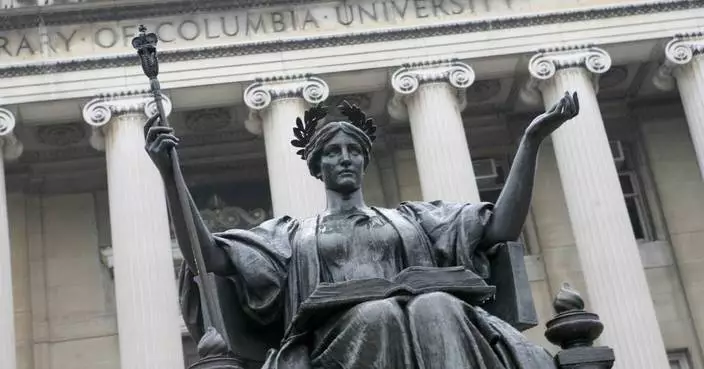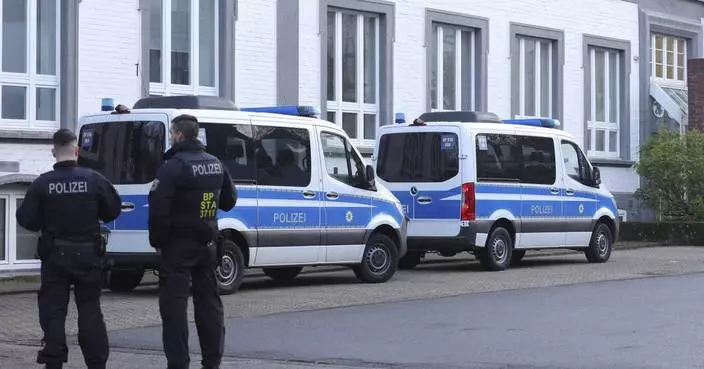China's defunct and reportedly out-of-control Tiangong 1 space station is expected to re-enter Earth's atmosphere sometime this weekend. It poses only a slight risk to people and property on the ground, since most of the bus-size, 8.5-ton vehicle is expected to burn up on re-entry, although space agencies don't know exactly when or where that will happen.
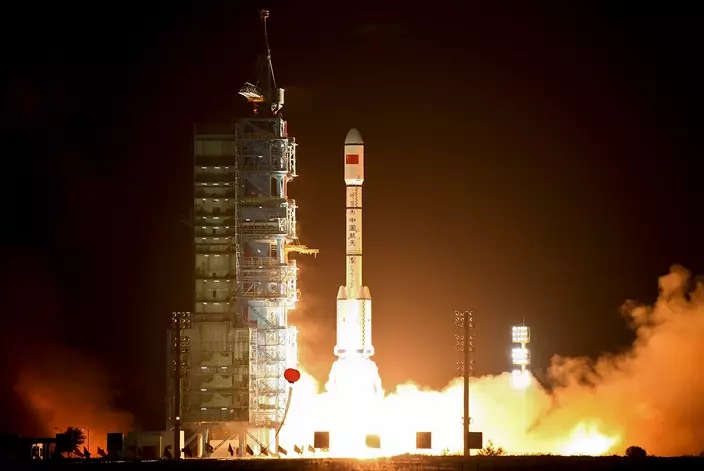
In this Sept. 29, 2011, file photo, a Long March-2FT1 carrier rocket loaded with China's Tiangong-1 space station blasts off from the launch pad at the Jiuquan Satellite Launch Center in northwest China's Gansu Province. (Color China Photo via AP, File)
Below are some questions and answers about the station, its re-entry and the past and future of China's ambitious space program.
Click to Gallery
China's defunct and reportedly out-of-control Tiangong 1 space station is expected to re-enter Earth's atmosphere sometime this weekend. It poses only a slight risk to people and property on the ground, since most of the bus-size, 8.5-ton vehicle is expected to burn up on re-entry, although space agencies don't know exactly when or where that will happen.
Below are some questions and answers about the station, its re-entry and the past and future of China's ambitious space program.
Western space experts say they believe China has lost control of the station. China's chief space laboratory designer Zhu Zongpeng has denied Tiangong was out of control, but hasn't provided specifics on what, if anything, China is doing to guide the craft's re-entry.
Based on its size, only about 10 percent of the spacecraft will likely survive being burned up on re-entry, mainly its heavier components such as its engines. The chances of anyone person on Earth being hit by debris is considered less than one in a trillion.
Ren Guoqiang, China's defense ministry spokesman, told reporters Thursday that Beijing has been briefing the United Nations and the international community about Tiangong 1's re-entry through multiple channels.
The breakup on re-entry of the Columbia space shuttle in 2003 killed all seven astronauts and sent more than 80,000 pieces of debris raining down on a large swath of the Southern United States. No one on the ground was injured.
___
WHAT WILL HAPPEN AND HOW GREAT IS THE DANGER?
The European Space Agency predicts the station will re-enter the atmosphere between Saturday morning and Sunday afternoon — an estimate it calls "highly variable," likely because the ever-changing shape of the upper atmosphere affects the speed of objects falling into it.
The Chinese space agency's latest estimate puts re-entry between Saturday and Wednesday.
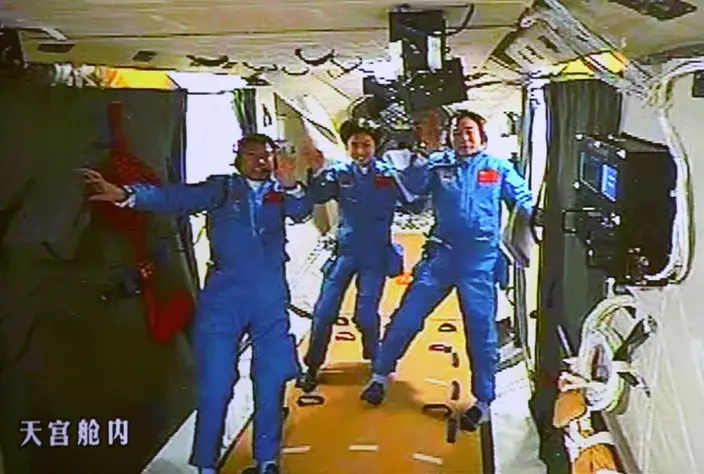
In this June 18, 2012, file image released by China's Xinhua News Agency, Chinese astronauts, from left, Liu Wang, Liu Yang and Jing Haipeng wave while aboard the orbiting Tiangong-1 space station. (Beijing Aerospace Control Center/Xinhua via AP)
Western space experts say they believe China has lost control of the station. China's chief space laboratory designer Zhu Zongpeng has denied Tiangong was out of control, but hasn't provided specifics on what, if anything, China is doing to guide the craft's re-entry.
Based on Tiangong 1's orbit, it will come to Earth somewhere between latitudes of 43 degrees north and 43 degrees south, or roughly somewhere over most of the United States, China, Africa, southern Europe, Australia and South America. Out of range are Russia, Canada and northern Europe.
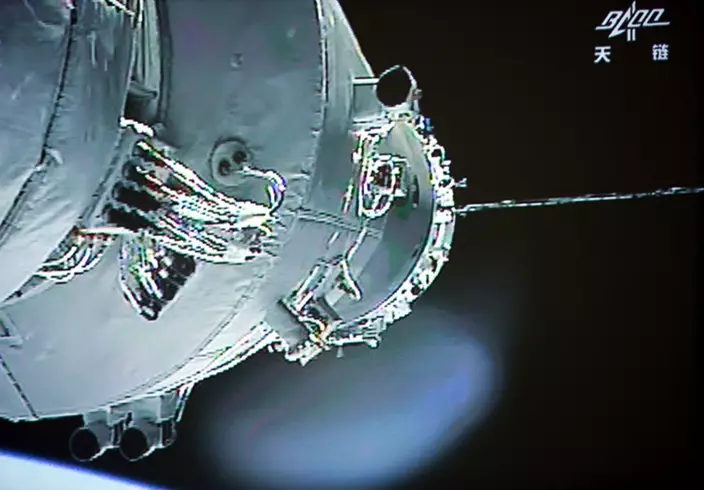
In this June 13, 2013, file image released by China's Xinhua News Agency, the Shenzhou-10 manned spacecraft is seen while conducting docking with the orbiting Tiangong-1 space module. (Beijing Aerospace Control Center/Xinhua via AP, File)
Based on its size, only about 10 percent of the spacecraft will likely survive being burned up on re-entry, mainly its heavier components such as its engines. The chances of anyone person on Earth being hit by debris is considered less than one in a trillion.
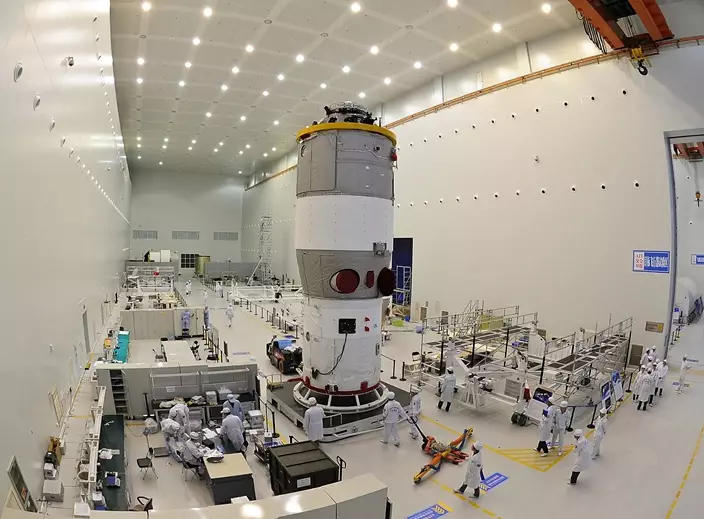
This undated file photo shows researchers testing China's first space station module Tiangong-1 at the Jiuquan Satellite Launch Center in northwest China's Gansu Province prior to its launch on Sept. 29, 2011. (Color China Photo via AP, File)
Ren Guoqiang, China's defense ministry spokesman, told reporters Thursday that Beijing has been briefing the United Nations and the international community about Tiangong 1's re-entry through multiple channels.
___
HOW COMMON IS MAN-MADE SPACE DEBRIS?
Debris from satellites, space launches and the International Space Station enters the atmosphere every few months, but only one person is known to have been hit by any of it: American woman Lottie Williams, who was struck but not injured by a falling piece of a U.S. Delta II rocket while exercising in an Oklahoma park in 1997.
Most famously, America's 77-ton Skylab crashed through the atmosphere in 1979, spreading pieces of wreckage near the southwestern Australia city of Perth, which fined the U.S. $400 for littering.

This undated file photo shows researchers installing China's first space station module Tiangong-1 at the Jiuquan Satellite Launch Center in northwest China's Gansu Province prior to its launch on Sept. 29, 2011. (Color China Photo via AP, File)
The breakup on re-entry of the Columbia space shuttle in 2003 killed all seven astronauts and sent more than 80,000 pieces of debris raining down on a large swath of the Southern United States. No one on the ground was injured.
In 2011, NASA's Upper Atmosphere Research Satellite was considered to pose a slight risk to the public when it came down to Earth 20 years after its launching. Debris from the 6-ton satellite ended up falling into the Pacific Ocean, causing no damage.
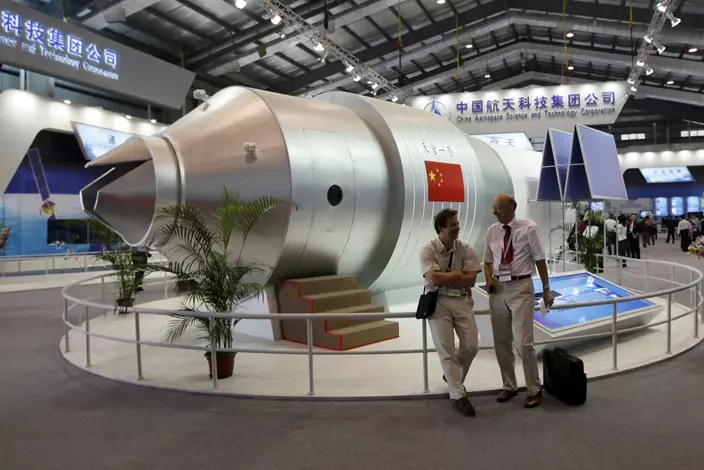
In this Nov. 16, 2010 file photo, visitors sit beside a model of China's Tiangong-1 space station at the 8th China International Aviation and Aerospace Exhibition in Zhuhai in southern China's Guangdong Province. (AP Photo/Kin Cheung, File)
China's own space program raised major concerns after it used a missile to destroy an out-of-service Chinese satellite in 2007, creating a large and potentially dangerous cloud of debris.
___
WHAT IS TIANGONG 1 AND WHAT WAS IT USED FOR?
Launched in 2011, Tiangong 1 was China's first space station, serving as an experimental platform for bigger projects such as the Tiangong 2 launched in September 2016 and a future permanent Chinese space station.
The station, whose name translates as "Heavenly Palace," played host to two crewed missions that included China's first female astronauts and served as a test platform for perfecting docking procedures and other operations. Its last crew departed in 2013 and contact with it was cut in 2016. Since then it has been orbiting gradually closer and closer to Earth on its own while being monitored.
The station had two modules, one for its solar panels and engines, and one for a pair of astronauts to live in and conduct experiments. A third astronaut slept in the Shenzhou spaceships that docked with the station, which also contained facilities for personal hygiene and food preparation.
___
HOW ADVANCED IS CHINA'S SPACE PROGRAM?
Since China conducted its first crewed mission in 2003 — becoming only the third country after Russia and the U.S. to do so — it has taken on increasingly ambitious projects, including staging a spacewalk and landing its Jade Rabbit rover on the moon.
China now operates the Tiangong 2 precursor space station facility, while the permanent station's 20-ton core module is due to be launched this year. The completed 60-ton station is set to come into full service in 2022 and operate for at least a decade.
China was excluded from the 420-ton International Space Station mainly due to U.S. legislation barring such cooperation and concerns over the Chinese space program's strong military connections. China's space program remains highly secretive and some experts have complained that a lack of information about Tiangong 1's design has made it harder to predict what might happen upon its re-entry.
A mission to land another rover on Mars and bring back samples is set to launch in 2020. China also plans to become the first country to soft-land a probe on the far side of the moon.
JAKARTA, Indonesia (AP) — Chinese Foreign Minister Wang Yi attacked the United States for earlier blocking United Nations resolutions calling for a cease-fire in Gaza after a meeting with his counterpart in Indonesia.
The Chinese and Indonesian foreign ministers reiterated their countries' calls for an immediate and lasting cease-fire in Gaza after a meeting in Jakarta on Thursday, condemning the humanitarian costs of Israel's ongoing war against Hamas.
The U.S., together with Egypt and Qatar, brokered a brief cease-fire earlier in the war that included some swaps of hostages taken by Hamas and other militant groups in return for Palestinian prisoners held by Israel, and has sought to bring about a new deal.
But the U.S. vetoed a number of proposed U.N. Security Council cease-fire resolutions because they didn’t tie the calls directly to the release of Israel hostages or condemn Hamas’ attack that prompted the war before allowing a resolution to a pass with an abstention in late March.
The meeting took place on the second day of a six-day tour during which Chinese Foreign Minister Wang Yi will also visit Papua New Guinea and Cambodia.
Indonesia's Minister of Foreign Affairs Retno Marsudi told reporters that the two countries share the same view about the importance of a cease-fire and of resolving the Palestinian problem through a two-state solution.
Indonesia, the world's most populous Muslim-majority country, has long been a strong supporter of the Palestinians and does not recognize Israel.
“I am sure that China would use its influence to prevent escalation,” Marsudi said, adding that China and Indonesia "would also fully support Palestine’s membership in the U.N.”
Wang blamed the United States for holding up cease-fire resolutions at the U.N.
“The conflict in Gaza has lasted for half a year and caused a rare humanitarian tragedy in the 21st century. The United Nations Security Council responded to the call of the international community and continued to review the resolution draft on the cease-fire in Gaza, but it was repeatedly vetoed by the United States,” Wang told reporters.
American officials have argued that the cease-fire and hostage releases are linked, while Russia, China and many other council members favored unconditional calls for a cease-fire. China and Russia also vetoed one U.S.-backed cease-fire resolution, saying it was not strong enough.
Referring to the resolution that was approved by the Security Council in March, Wang said: “This time, the U.S. did not dare to stand in opposition to international morality and chose to abstain. However, the U.S. claimed that this resolution was not binding," Wang said. “In the eyes of the United States, international law seems to be a tool that can be used whenever it finds useful and discarded if it does not want to use it.”
The two ministers also discussed their countries' economic relationship and the South China Sea.
China is Indonesia’s largest trading partner, with the trade volume reaching more than $127 billion. China is also one of Indonesia's largest foreign investors, with investment flows of more than $7.4 billion in 2023.
Later Thursday, Wang also met Indonesian President Joko Widodo and president-elect Prabowo Subianto, who is currently defense minister.

Indonesian President-elect and current Defense Minister Prabowo Subianto, left, greets Chinese Foreign Minister Wang Yi in Jakarta, Indonesia, Thursday, April 18, 2024. The Chinese and Indonesian foreign ministers called for an immediate and lasting cease-fire in Gaza after a meeting in Jakarta on Thursday, condemning the humanitarian costs of the ongoing war that has killed tens of thousands of Palestinians. (AP Photo/Achmad Ibrahim)
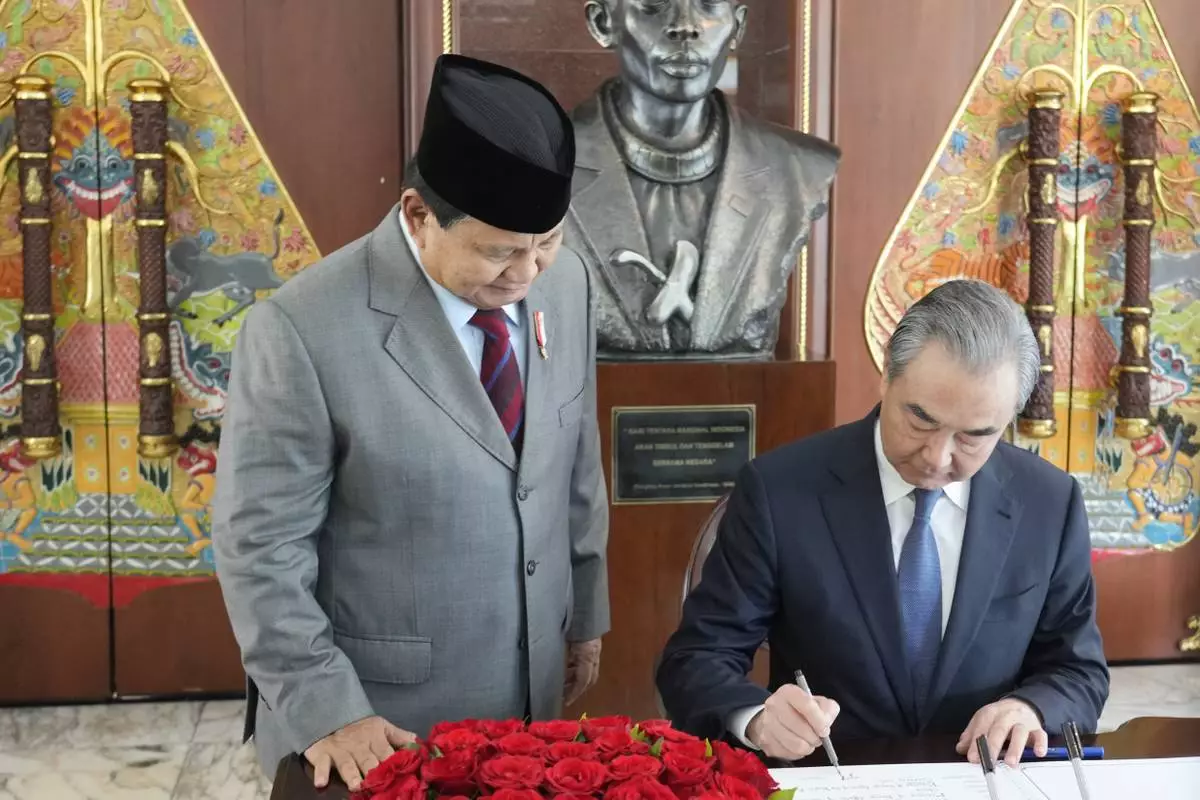
Indonesian President-elect and current Defense Minister Prabowo Subianto, left, stands next to Chinese Foreign Minister Wang Yi as Wang signs a guest book in Jakarta, Indonesia, Thursday, April 18, 2024. (AP Photo/Achmad Ibrahim/Pool)
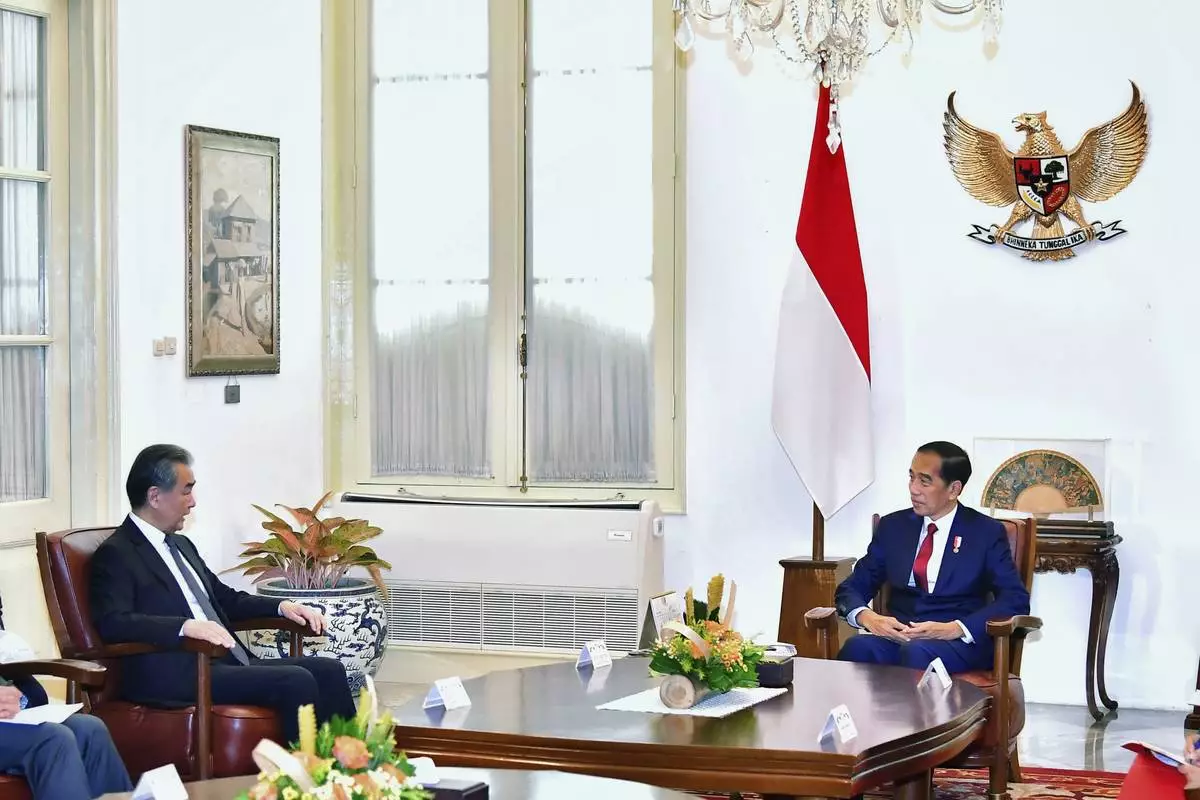
In this photo provided by the Indonesian Presidential Palace, Chinese Foreign Minister Wang Yi, left, talks with Indonesia President Joko Widodo during a meeting at the palace in Jakarta, Indonesia, Thursday, April 18, 2024. The Chinese and Indonesian foreign ministers called for an immediate and lasting cease-fire in Gaza after a meeting in Jakarta on Thursday, condemning the humanitarian costs of Israel's ongoing war against Hamas. (Vico/Indonesian Presidential Palace via AP)
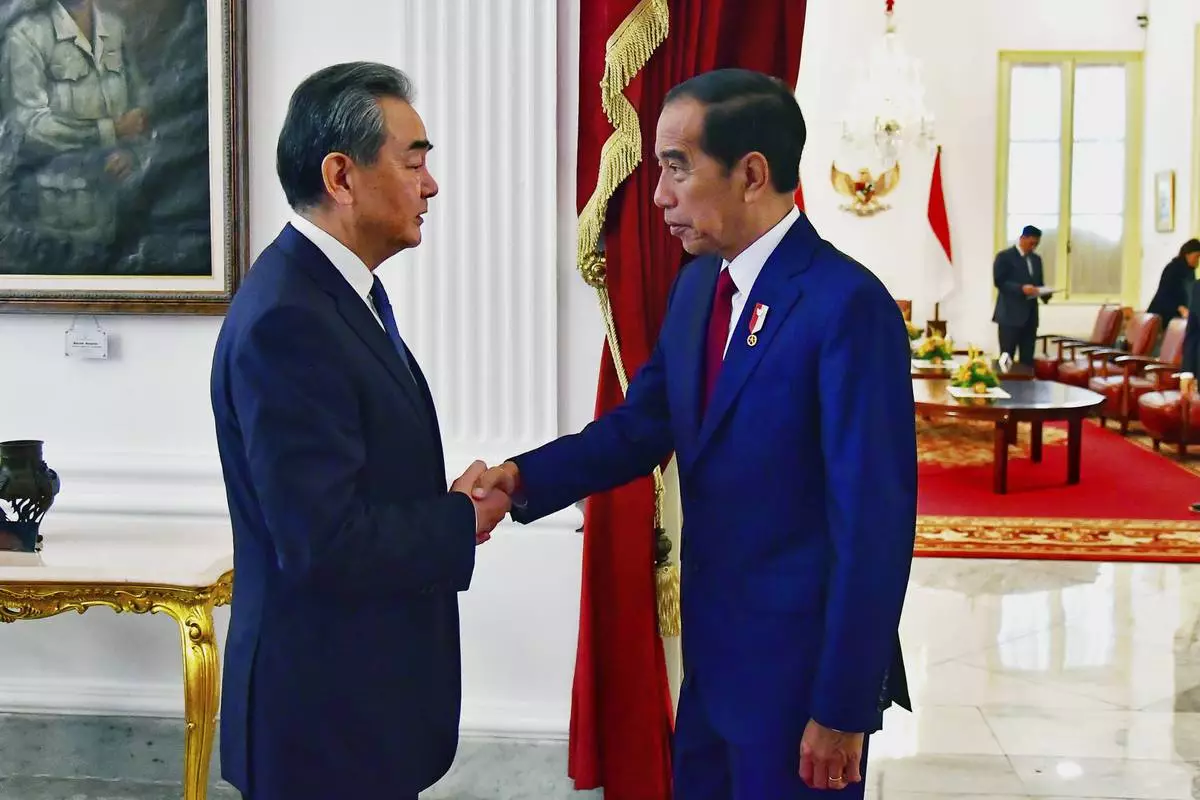
In this photo provided by the Indonesian Presidential Palace, Chinese Foreign Minister Wang Yi , left, shakes hands with Indonesia President Joko Widodo during a meeting at the palace in Jakarta, Indonesia, Thursday, April 18, 2024. The Chinese and Indonesian foreign ministers called for an immediate and lasting cease-fire in Gaza after a meeting in Jakarta on Thursday, condemning the humanitarian costs of Israel's ongoing war against Hamas. (Vico/Indonesian Presidential Palace via AP)
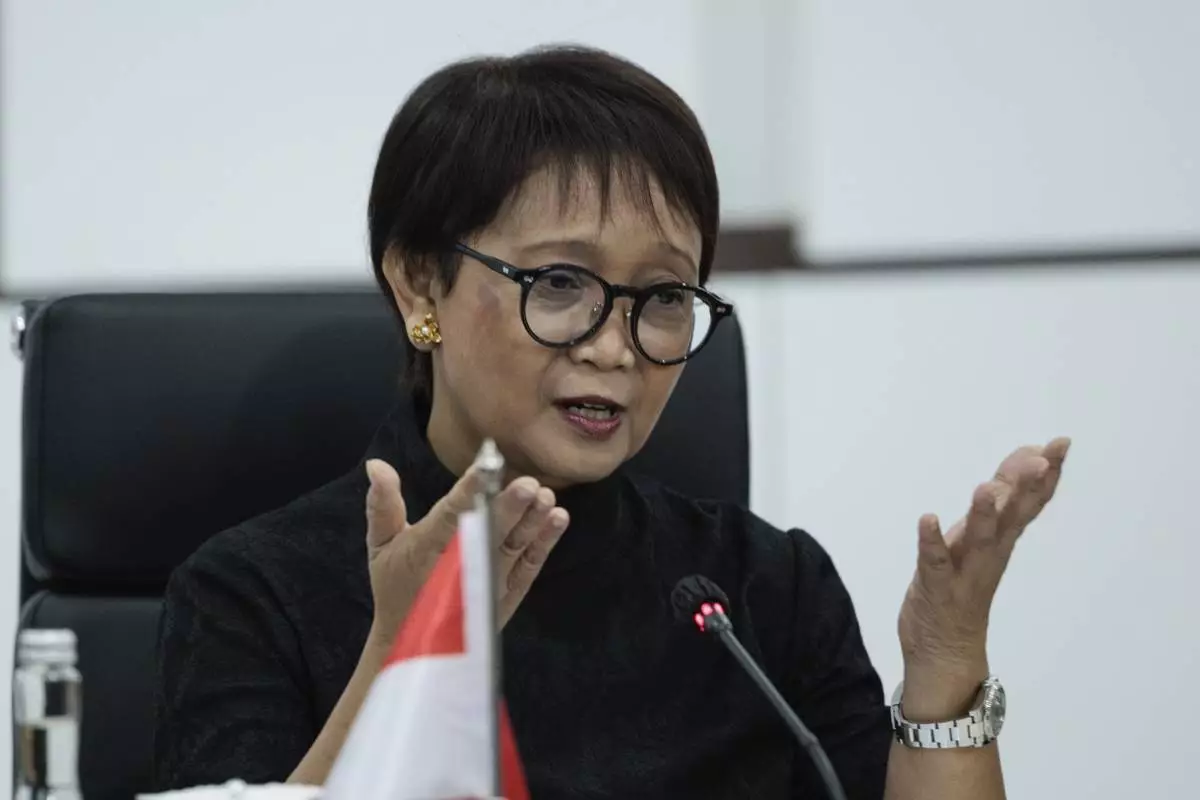
Indonesian Foreign Minister Retno Marsudi gestures as she speaks during a bilateral meeting with Chinese Foreign Minister Wang Yi in Jakarta, Indonesia, Thursday, April 18, 2024. The Chinese and Indonesian foreign ministers called for an immediate and lasting cease-fire in Gaza after a meeting in Jakarta on Thursday, condemning the humanitarian costs of the ongoing war that has killed tens of thousands of Palestinians. (Yasuyoshi Chiba/Pool Photo via AP)

Chinese Foreign Minister Wang Yi arrives for a bilateral meeting with Indonesian Foreign Minister Retno Marsudi in Jakarta, Indonesia, Thursday, April 18, 2024. (Willy Kurniawan/Pool Photo via AP)

Indonesian Foreign Minister Retno Marsudi, right, shakes hands with Chinese Foreign Minister Wang Yi during their bilateral meeting in Jakarta, Indonesia, Thursday, April 18, 2024. (Yasuyoshi Chiba/Pool Photo via AP)
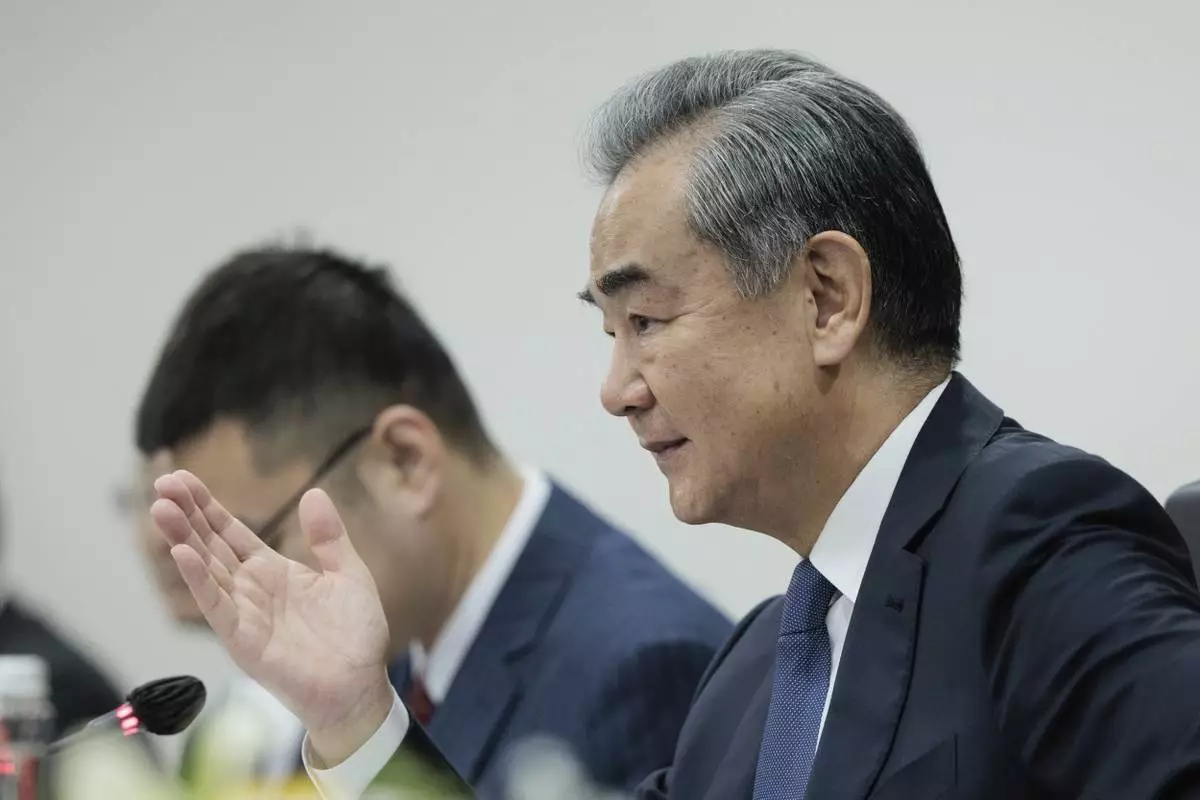
Chinese Foreign Minister Wang Yi gestures as he speaks during his bilateral meeting with Indonesian Foreign Minister Retno Marsudi in Jakarta, Indonesia, Thursday, April 18, 2024. (Yasuyoshi Chiba/Pool Photo via AP)

Indonesian Foreign Minister Retno Marsudi, left, speaks during their bilateral meeting with Chinese Foreign Minister Wang Yi, right, in Jakarta, Indonesia, Thursday, April 18, 2024. (Yasuyoshi Chiba/Pool Photo via AP)
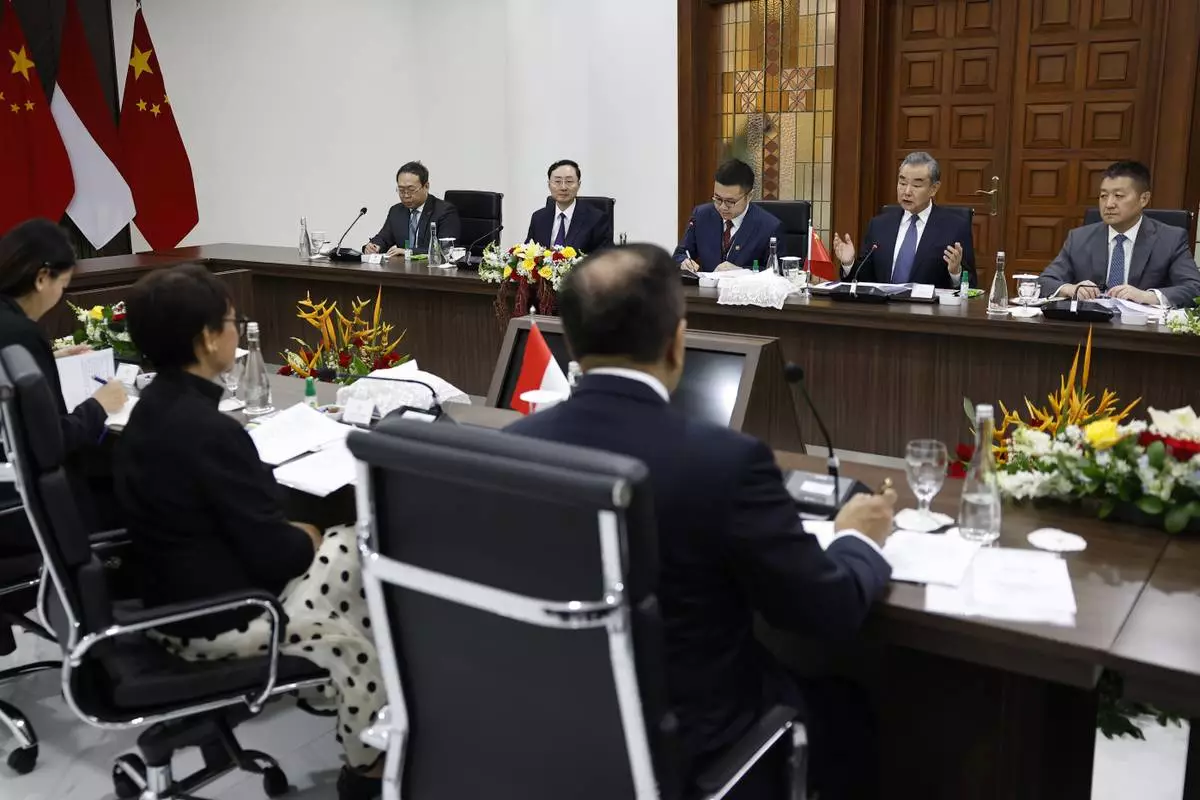
Chinese Foreign Minister Wang Yi, second right, speaks during a bilateral meeting with Indonesian Foreign Minister Retno Marsudi, bottom second left, in Jakarta, Indonesia, Thursday, April 18, 2024. (Willy Kurniawan/Pool Photo via AP)
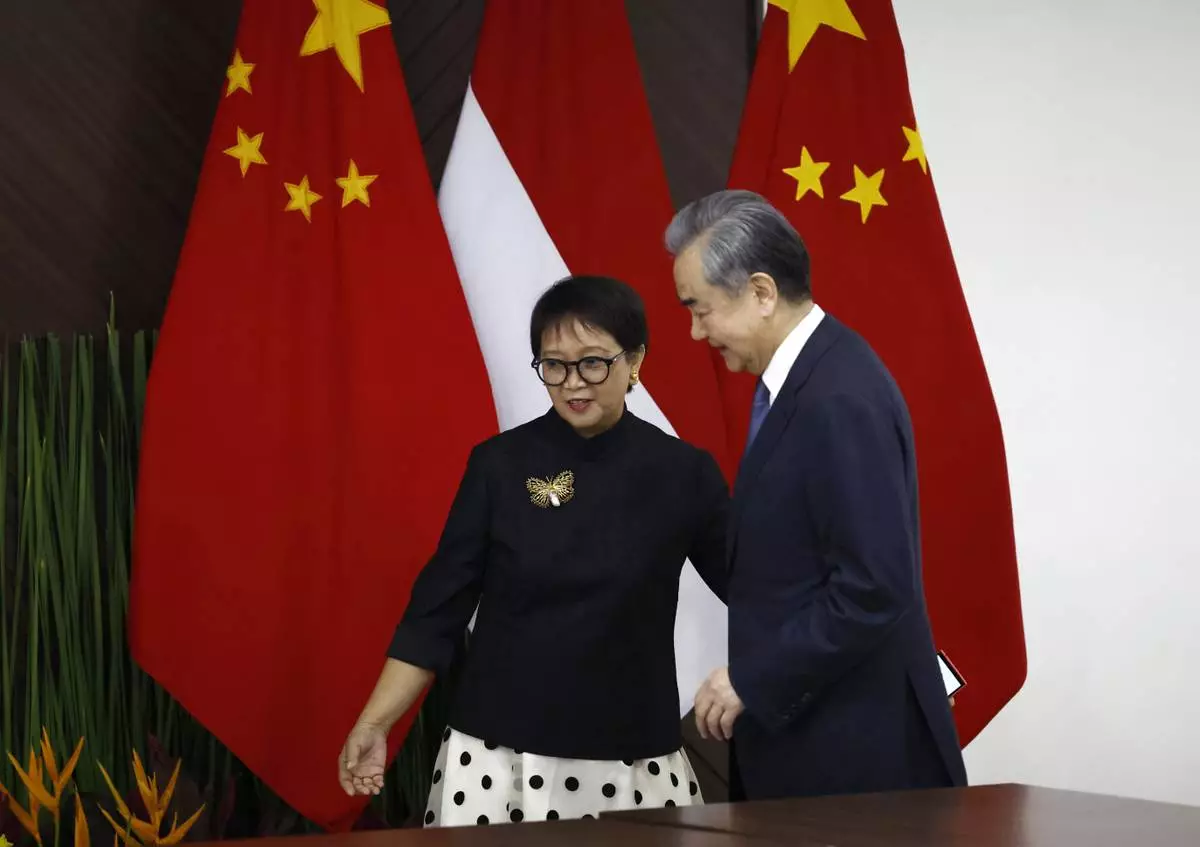
Chinese Foreign Minister Wang Yi, right, walks with Indonesian Foreign Minister Retno Marsudi during their bilateral meeting in Jakarta, Indonesia, Thursday, April 18, 2024. (Willy Kurniawan/Pool Photo via AP)






















